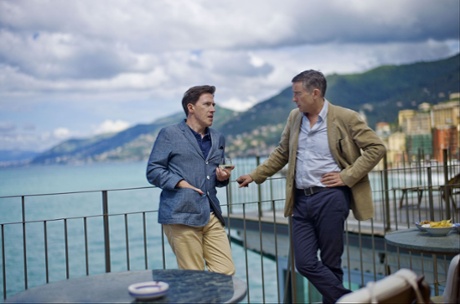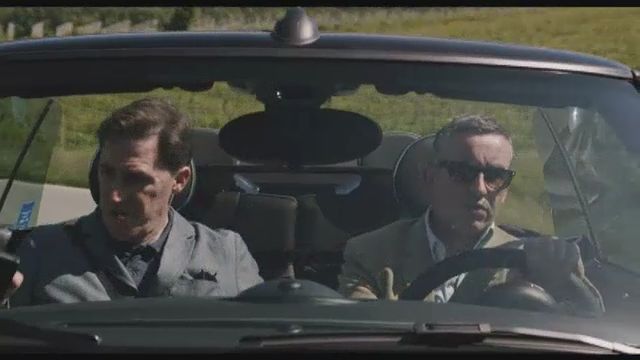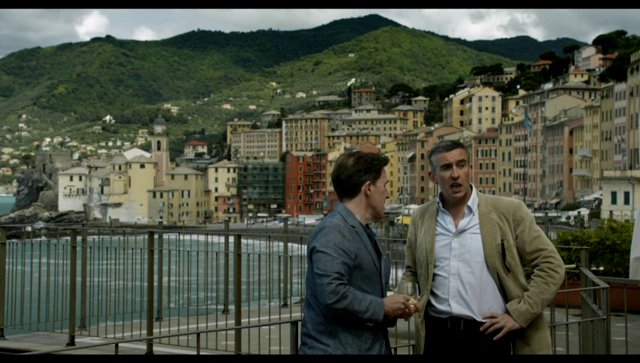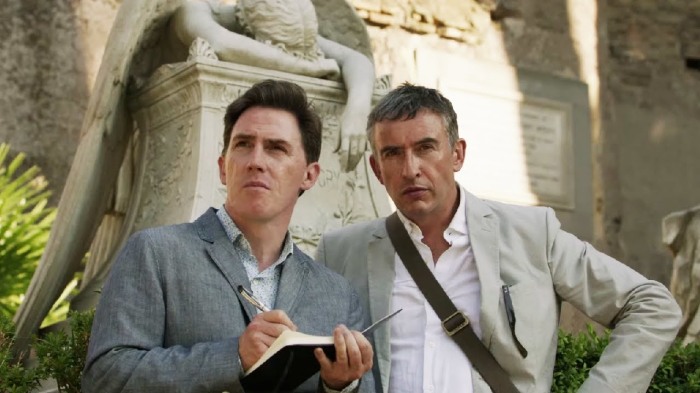The Trip was on odd film, a travel film that brought the audience closer to the characters due to their constant loquacious attempts to keep everyone at a distance. Although much of the comedic film was improvised, room was left alongside the epicurean delights for squirmy feelings of loneliness and misgivings. The sequel, the Trip to Italy, reunites Steve Coogan and Rob Brydon again on another dine in journey (I won’t spoil where), this time upping the emotional stakes. The Trip’s form is preserved, but the Trip to Italy expands the secret menu from career aspirations to include loyalty and death. These elements create a film that is darkly funny and also relevantly quotidian.
 |
| Probably talking about the queen and the crown jewels and such |
The Trip to Italy again finds Coogan and Brydon playing parallel universe versions of themselves. Both are British comedians who have had dalliances with fame but never hit super star status. Much of the humor in the film comes from their professional rivalry, an uneven match that none the less finds both men fiercely defensive. Instead of coming to blows though they trade impressions, academically criticizing each other’s Pacino’s and Michael Caine’s. An uneasy truce is found mocking the raspy Tom Hardy voice from The Dark Knight Rises. These chatty Crown citizens trade repartee over four star dishes, perfectly arranged comestibles which make up unspoken climaxes of each segment. The Trip to Italy preserves the tradition of making space in the movie for the food to speak. That’s not to say this is a talkative travelogue though, not really. Along with the sweeping vistas that accompany travel segments, including a stunning Camogli restaurant on a private beach that requires a ferry, we are exposed to flashes of Italy almost without context. We learn more explicit details about British expatriates Percy Shelley and Lord Byron than we do about anything Italian. Which is of course because we are following two other similar expatriates, Coogan and Brydon, who’s careers have driven them abroad (albeit to the United States). Although masquerading as a Discovery Channel piece, the Trip to Italy spends more time on existential crisis.
 |
| I seriously could not find a promo still without the two of these guys |
The films are not strongly plotted enough to make The Trip required viewing before The Trip to Italy, but much of the improvements in this film are based on incremental changes to the dynamics from the first movie. The relationship between Coogan and Brydon has subtly shifted due to changes in their careers and families, removing much of the disparity that fed Coogan’s bluster in the first film. The verbal fencing takes on a more vicious air as a result, such as in one demeaning exchange in Pompei that requires Brydon to spend a moment talking to a corpse to work his confidence back up. Yet the uncertainty is unconscious, as both men seem to begrudgingly acknowledge their growing kinship despite only interacting with each other on these jaunts. Even if they can’t verbalize their excitement for the trip when they first meet back up, small signs of respect crop up like Coogan turning over the Mini’s wheel occasionally while they wind through cypress dappled mountain roads. The journey is a time when the pair can carefully unpack feelings, a luxury denied when ensconced in everyday business.
Why is it that couples fight on vacation? Folk wisdom proffers that it’s because they are forced to spend time with each other, but the Trip to Italy suggests something different I think. Coogan and Brydon unravel on the trip to some extent, as the mental space afforded by being on vacation creates doubts and yearning in their minds. Their only job is to eat oysters and visit catacombs, but the side effect of staring into perfect sunsets is it cracks open philosophical tensions that they (and we) live with unresolved. Am I doing something meaningful with my life? Are the sacrifices worth what I get? In both films, but especially in the Trip to Italy, the classical art, good food, and stirring vistas trigger these questions in otherwise confident and driven professionals. What hope do the rest of us have on a trip to Tahiti? The film reinforces the prevalence of lurking crisis by humanizing the trip as much as possible. Coogan and Brydon are not food critics or historians, so a mundane element is introduced to the parts of Italy they consume. Food is remarked upon, then quickly forgotten as an impression is lobbed over the dinner table. Coogan, often in contempt of history, openly wonders at the catacombs why someone would want to hang out with a bunch of dead people. Although The Trip to Italy is obviously dealing with bourgeois issues, the doubts and misgivings are presented in a casual manner rendering them relatable to anyone.
 |
| After two of these films, your Steve Coogan impression can now consist of going on vacation and getting sauced |
So what can we learn from a couple British comedians caravanning through Europe? Although fans from the first film will not be surprised, there is a surprisingly deep connection to the human experience running through these films. It is presented in an experimental comedic fashion that actually accentuates the reality of these characters more than can be found in sour and dour indie films on the same subject. Furthermore, The Trip to Italy ups the ante on its predecessor, with a sunnier country but deeper discussion. Although its casual premise may initially seem bizarre for the big screen, the airy vacation film ends up finding synergy between humor and doubt.
3/4
Originally published on Synthetic Error October 27, 2014

Comments
Post a Comment